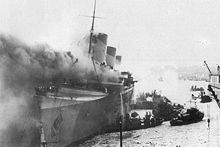Operation Underworld - Wikipedia
Operation Underworld was the United States government's code name for the cooperation of Italian and Jewish organized crime figures from 1942 to 1945 to counter Axis spies and saboteurs along the U.S. northeastern seaboard ports, avoid wartime labor union strikes, and limit theft by black-marketeers of vital war supplies and equipment.

Suspicion about Mafia sabotage in the fire and sinking of the
Normandie(renamed the
Lafayettefor war service), led to Operation Underworld
In the first three months after the Attack on Pearl Harbor on December 7, 1941, the U.S. lost 120 merchant ships to German U-boats and surface raiders in the Battle of the Atlantic and in February 1942 the ocean liner SS Normandie – a captured French ship that was being refitted as a troop ship in New York harbor – was allegedly sabotaged and sunk by arson in the Port of New York. The Mafia boss Albert Anastasia claimed responsibility for the sabotage.[1] Although the United States government claimed the loss of the Normandie was accident, many Americans were skeptical and thought the destruction was planned by the Nazis. Several Axis spies and saboteurs were arrested and hanged for their crimes but no evidence was ever produced linking Axis spies to the loss of the Normandie. After the war, Axis records claimed no sabotage operation had existed and no evidence has ever been produced on the Allied side to indicate there had been underworld sabotage.[2] The Normandie had a very efficient fire protection system but it was conveniently disconnected during the conversion. With sparks from a welding torch, Clement Derrick ignited a stack of life vests filled with flammable kapok, the fire quickly spread and eventually so much water was used to put the fire out that the ship became too heavy. Nobody knows if Clement Derrick had been paid by the underworld to burn the ship. The ship's designer Vladimir Yourkevitch arrived at the burning ship to offer his expertise and was barred by harbor police, his idea was to enter the vessel and open the sea-cocks which would flood the lower decks and make the ship stabilize, then water could be pumped into burning areas without the risk of capsize. [3] The suggestion was rejected by the commander of the 3rd Naval District, Rear Admiral Adolphus Andrews.
Nevertheless, fears about possible sabotage or disruption of the waterfront led Commander Charles R. Haffenden of the U.S. Navy Office of Naval Intelligence (ONI) Third Naval District in New York to set up a special security unit. He sought the help of Joseph Lanza, who ran the Fulton Fish Market, to get intelligence about the New York waterfront, control the labor unions, and identify possible refueling and resupply operations for German submarines with the help of the fishing industry along the Atlantic Coast. To cover Lanza’s activities, he was suggested to approach Charles Luciano who was an important boss of the five New York Mafia crime families. Luciano agreed to cooperate with authorities in hopes of consideration for early release from prison.[4]
Luciano was in Dannemora at the time, serving a 30 to 50-year sentence for running a prostitution ring. For his cooperation he was moved to a more convenient and comfortable open prison in Great Meadows in May 1942.[5] Luciano’s influence in stopping sabotage remains unclear, but authorities did note that strikes on the docks stopped after Luciano’s attorney Moses Polakoff contacted underworld figures with influence over the longshoremen and their unions.[6] In 1946 Luciano's sentence was commuted – after serving 9½ years – and he was deported to his native Italy.[7]
References [ edit ]
- ^ Newark, Mafia Allies, pp. 83-98
- ^ Campbell, The Luciano Project, p. 29
- ^ Ardman 1985, p. 147, 184–85, 205, 218, 238, 325–26
- ^ Newark, Mafia Allies, pp. 99-111
- ^ Newark, Mafia Allies, p. 103
- ^ Campbell, The Luciano Project, pp. 111-127
- ^ Campbell, The Luciano Project, pp. 233 ff.
- Campbell, Rodney (1977). The Luciano Project: The Secret Wartime Collaboration of the Mafia and the U.S. Navy, New York: McGraw-Hill, ISBN 0-07-009674-0
- Newark, Tim (2007). Mafia Allies. The True Story of America’s Secret Alliance with the Mob in World War II, Saint Paul (MN): Zenith Press ISBN 0-7603-2457-3 (Review)